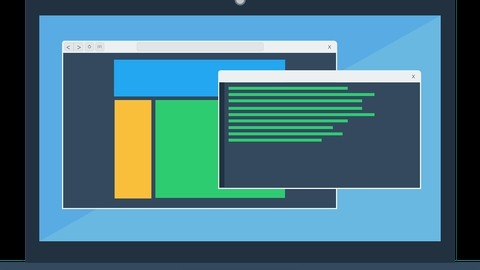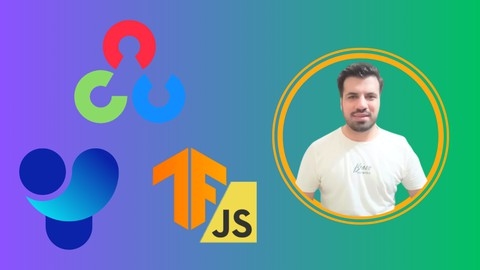TensorFlow.js is an exciting library that empowers JavaScript developers to implement machine learning models within web applications.
It’s a powerful tool that can be used for image recognition, natural language processing, and more, bringing the power of AI to web experiences.
By learning TensorFlow.js, you can unlock the potential to build interactive and intelligent web applications, pushing the boundaries of what’s possible.
Finding a great TensorFlow.js course on Udemy can feel like searching for a needle in a haystack.
With so many courses available, it’s hard to know which one will provide the right mix of theoretical knowledge, practical skills, and engaging content.
You’re looking for a course that doesn’t just teach you the syntax, but also dives into the core concepts and guides you through hands-on projects.
For the best TensorFlow.js course overall on Udemy, we recommend Machine Learning in JavaScript with TensorFlow.js by the team at The Net Ninja.
This comprehensive course guides you through everything from the fundamentals of machine learning to building real-world applications, all while using JavaScript.
You’ll learn about neural networks, tensors, data preparation, model training, and deployment, making this course a perfect starting point for your TensorFlow.js journey.
While this is our top pick, there are other fantastic TensorFlow.js courses available.
Keep reading to discover our recommendations based on different learning styles, career goals, and specific areas of interest within TensorFlow.js.
Machine Learning in JavaScript with TensorFlow.js
The course starts by introducing you to TensorFlow.js, an open-source library that brings Google’s machine learning capabilities to the JavaScript ecosystem.
You’ll learn the core concepts behind machine learning and neural networks through interactive visualizations.
The course then dives into installing and running TensorFlow.js in different environments like the browser, Node.js, and even React Native apps.
You’ll optimize performance using WebGL and understand memory management.
The fundamentals of tensors and tensor operations are covered in-depth.
Data preparation is crucial for machine learning models.
This course walks you through loading data from CSV files, visualizing it, splitting into training/testing sets, and preprocessing techniques like normalization.
You’ll build your first model for linear regression using the user-friendly Layers API.
Once the model is defined, you’ll learn how to train it on your data using model.fit() and visualize training progress.
Model evaluation metrics like loss are explained clearly.
You’ll integrate your trained TensorFlow.js model into web UIs and save/load models for later use.
The course progresses to binary and multi-class classification problems, covering data visualization, one-hot encoding, and prediction visualization via heatmaps.
You’ll build and train classification models step-by-step.
Throughout, you’ll apply concepts through hands-on labs, quizzes, and an optional advanced lab on training without the Layers API.
The course wraps up with a review, next steps, and resources to continue your TensorFlow.js journey.
Beginners Machine Learning Masterclass with Tensorflow JS
You’ll begin with the fundamentals, learning how to create and manipulate tensors – the building blocks of machine learning – and perform basic mathematical operations.
You’ll then explore data visualization techniques, building scatter plots, bar charts, and histograms to gain insights from your data.
The course progressively guides you through the development of machine learning models.
You’ll learn to construct linear regression models and visualize them dynamically using user input.
You’ll then delve into polynomial regression, a more complex type of regression, exploring techniques for training, prediction, and error visualization.
Finally, you’ll tackle image classification using the K-Nearest Neighbors algorithm.
You’ll learn how to load models into HTML, train them on image datasets, and make predictions.
Throughout the course, you’ll be coding in JavaScript, a core language for web development, making your skills readily transferable to various web applications.
This course provides a solid foundation in machine learning concepts and their implementation using TensorFlow.js, making it ideal for aspiring data scientists, web developers, and anyone seeking to explore the exciting world of machine learning in the browser.
Computer Vision Web Development: YOLOv8 and TensorFlow.js
You’ll embark on a journey through the fascinating world of image and video analysis, gaining hands-on experience with essential tools like TensorFlow.js, YOLOv8, and OpenCV.js.
The learning path starts with a solid foundation in OpenCV.js, where you’ll master the fundamentals of image manipulation.
You’ll learn to perform tasks such as blurring, edge detection, and color recognition, setting the stage for more advanced projects.
Next, you’ll dive into the realm of object detection, utilizing the robust frameworks of COCO-SSD and YOLOv8.
You’ll discover the power of these technologies as you build applications capable of identifying objects in images and videos.
From recognizing faces to detecting personal protective equipment, you’ll gain practical skills in real-time object detection.
The course also emphasizes the ability to fine-tune and train YOLOv8 models on custom datasets, allowing you to create tailored object detection systems for specific applications.
Finally, you’ll explore the integration of Tesseract.js to enable text recognition from images.
This opens up a range of possibilities, including license plate recognition.
You’ll learn to combine YOLOv8 and Tesseract to build a powerful application that can detect license plates and extract text information, taking your computer vision skills to the next level.
This course provides a well-structured learning experience, leading you through the core concepts of computer vision and equipping you with the necessary tools to create innovative web applications.
Deep Learning & Machine Learning Masterclass w/ TensorFlowJS
This course takes a comprehensive approach to TensorFlow.js, ensuring you have a solid foundation before diving into the world of machine learning.
You’ll begin by building a strong understanding of web development fundamentals like HTML, CSS, and JavaScript – essential for creating interactive experiences with your machine learning models.
The course gradually introduces you to machine learning and its connection with TensorFlow.js.
You’ll learn to work with tensors, the building blocks of deep learning models, and progressively gain hands-on experience building neural networks for various tasks, such as image classification and sentiment analysis.
You’ll get to work with real-world examples, like creating a neural network that recognizes lines in images, predicts iris species, and even classifies text sentiment.
You’ll also build a convolutional neural network for recognizing handwritten digits using the MNIST dataset.
This course is well-structured, offering clear explanations and practical applications.
The instructor demonstrates a strong grasp of the subject matter and guides you through each concept with clear examples and engaging exercises.
You’ll be able to build, train, and deploy your own models, opening up exciting opportunities in fields like image recognition, natural language processing, and more.
This course is particularly suitable for beginners looking for a comprehensive introduction to TensorFlow.js and machine learning.




